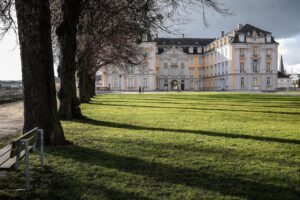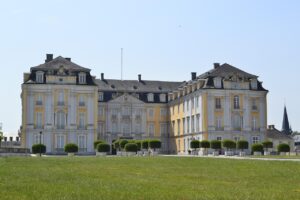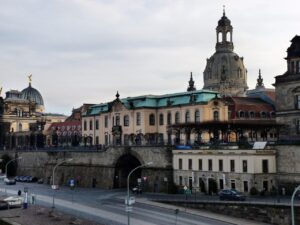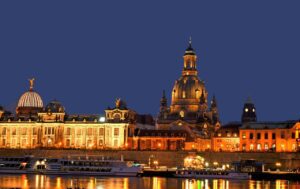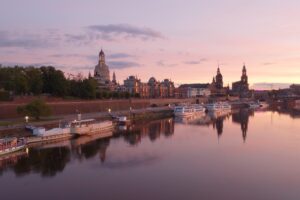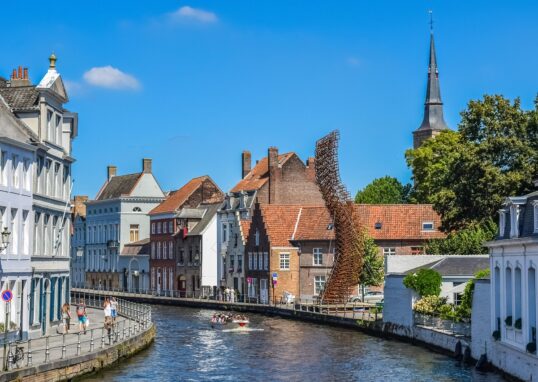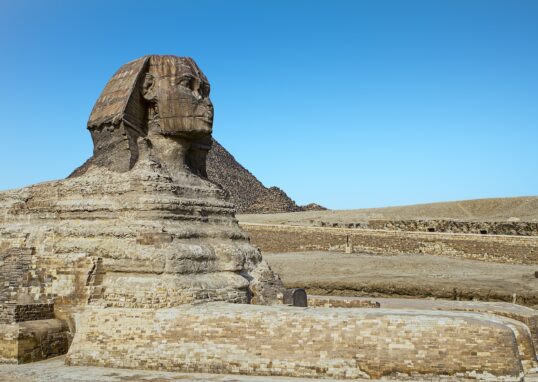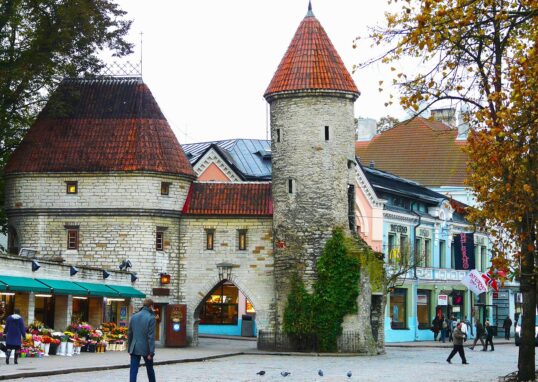
Castles of Augustusburg and Falkenlust at Brühl
The Augustusburg and Falkenlust Castles at Brühl are among the most wonderful examples of German Rococo and Baroque architecture. They are situated in the charming town of Brühl, midway between Cologne and Bonn, in the North Rhine-Westphalia region of Germany. These castles are set amidst picturesque gardens, green landscapes, and quiet forests. Augustusburg Palace and Falkenlust Palace were both built in the 18th century for Clemens August of Bavaria, Archbishop-Elector of Cologne. The two castles reflect his penchant for luxury, art, and elegance. The castles and gardens were added to the UNESCO World Heritage List in 1984 because of their outstanding architecture and artistic value. They remain an important part of German cultural history and are seen by thousands of visitors each year.
Historical Background 
Augustusburg Palace was built from 1725. It was designed by the architect Johann Conrad Schlaun, and later the famous François de Cuvilliés, a French architect who was highly regarded for his Rococo style of architecture. The palace was built on top of the ruins of a medieval castle that stood there before. Clemens August desired Augustusburg Palace to embody his power and prestige. It served as both his residence and a place where he entertained important guests and conducted lavish ceremonies. Later, between 1729 and 1740, Falkenlust Palace was built close to it. Falkenlust was smaller than Augustusburg but equally lovely. It served as a hunting lodge, especially for falconry, one of Clemens August’s favorite pursuits. “Falkenlust” is the “Pleasure of Falcons.” Both these palaces were connected by beautiful gardens and walks that indicated a balance between nature and architecture. The gardens were designed by French garden architect Dominique Girard, who was influenced by the grand style of Versailles.
Architecture of Augustusburg Palace
Augustusburg Palace is a paramount instance of Baroque and Rococo architecture in Germany. The building has a rectangular structure with three main wings in a U-shape around a vast courtyard. The exterior of the palace is symmetrical and elegant, with lightly colored facades and decorated details. The roof lines, towers, and heavily decorated windows form a quintessential example of 18th-century royal architecture. The most famous part of Augustusburg is the Grand Staircase, designed by Balthasar Neumann. It is one of Europe’s most exquisite staircases. The staircase features marble columns, graceful lines, and rich frescoes that give an illusion of movement and light. Inside the palace, every room is a work of art. The halls are decorated with mirrors, chandeliers, and gold decorations.
Falkenlust Palace
Falkenlust Palace is smaller but no less charming and exquisite. It was built as a retreat where Clemens August could spend time in seclusion and embark on hunting trips. The palace is surrounded by woods and meadows, offering a secluded and peaceful atmosphere. Falkenlust architecture mirrors the Rococo style in its lightness, curved lines, and elegant decorations. The interior rooms have beautiful paintings, marble fireplaces, and elaborate stucco works. Falkenlust was not only a hunting lodge but also an entertainment palace. The Elector and his guests often dined, had music, and dances here after a hunt.
The Gardens and Park 
The gardens between Augustusburg and Falkenlust are as lovely as the castles themselves. They represent the artistic harmony of architecture and nature, one of the predominant features of the Baroque period. The gardens were designed by Dominique Girard, who had previously worked in the gardens of Versailles. The layout includes symmetrical flowerbeds, long avenues, fountains, and ornamental ponds. The central axis of the garden leads the eye straight from the palace to the forest, creating an illusion of infinite beauty. The water features and sculptures add elegance to the overall landscape.
Cultural and Historical Importance
The Augustusburg and Falkenlust Castles are not only beautiful buildings, but a testament to the culture, art, and politics of 18th-century Germany. They reflect the French architectural style and the taste of the European nobility of the time. These palaces also demonstrate the power and wealth of the Electorate of Cologne. Clemens August was a religious figure in addition to being a prince of the Holy Roman Empire. The castles were representations of his dual role as a religious man and a man of power. In the 19th century, both castles survived wars and political unrest. In the 20th century, following World War II, they were carefully restored. Today, they are open to visitors and serve as museums in which the glory of the past is unveiled.
Visiting the Castles
A tour of the Castles of Augustusburg and Falkenlust is a memorable one. The town of Brühl is conveniently reached by train or automobile from Cologne or Bonn. The Augustusburg Palace offers guided tours that take the visitors through its main halls, staircases, and rooms. The Grand Staircase is the highlight of the tour and leaves all the visitors in awe of its artistic design. The gardens are open to the general public and can be strolled through on one’s own. In the summer months, the flowers are in full bloom, and the fountains create a soothing melody. Falkenlust Palace is a short walk from Augustusburg through a secluded forest path. A visit to the palace provides an overview of its diminutive rooms and falconry demonstrations. There is photography allowed in certain sections, but visitors are asked to respect the stillness of the place.
Festivals and Events 
The castle is not only a historical monument, but a cultural one as well. There are various concerts, exhibitions, and festivals held throughout the year. One of the most popular events is the Brühl Palace Concerts, held in summer. Classical music fills the palace courtyard, and the setting is enchanting under the stars. The region also features art exhibitions and seasonal markets, which enable visitors to experience German culture and handicrafts.
UNESCO World Heritage Recognition
The Augustusburg and Falkenlust Castles were added to the UNESCO World Heritage List in 1984. UNESCO designated them for their model example of Baroque and Rococo architectural style and influence on later palace constructions in Europe. The designation ensures their protection and preservation for future generations. It also recognizes the universal value of these masterpieces as examples of cultural exchange between France, Germany, and Italy.
Surrounding Places and Attractions Near the Castles
The Augustusburg and Falkenlust Castles are located in the peaceful town of Brühl, in the North Rhine-Westphalia region of Germany. While the castles are the main highlight, the vicinity around them offers a great mix of nature, history, culture, and entertainment. There are many beautiful sites, cities, parks, and museums nearby that make a visit even more enjoyable. No matter if you love serene gardens, vibrant cities, or scenic landscapes, the surroundings of Brühl have something for everyone.
Brühl Town
Let’s start with Brühl itself, the charming town that is home to these two castles. Brühl is compact but charming. The center of the town features cobblestone streets, old German homes, quaint cafés, and tiny bakeries. One can sit back in the market square and have a coffee or a piece of cake. There are a few interesting local sights as well. One of the most renowned is the Parish Church of St. Margaret. It has a beautiful façade and a peaceful interior. The church has stood there for centuries and fits into the old-world charm of the town perfectly. Additionally, the Brühl Town Museum tells tales of the residents and their traditions. It is an appropriate place to understand how Brühl transformed over the centuries. Walking in the town gives a feeling of warmth and tranquility, especially for slow tourists who adore it.
Phantasialand Theme Park
Right after Brühl is Phantasialand, which is one of Germany’s most famous and exciting theme parks. It’s only a few kilometers from the castles. The park consists of several theme worlds, such as Berlin, Mexico, China Town, Deep in Africa, and Fantasy. Phantasialand offers something for all ages. For families, there are soft rides and entertaining shows, and for thrill-seekers, there are renowned roller coasters such as Taron or Black Mamba. Great restaurants, beautiful gardens, and a wonderful night show with lights and music are also part of the park. During the Christmas season, Phantasialand is enchanting with winter decorations, winter shows, and Christmas markets. It is an unforgettable experience for visitors to Brühl.
Cologne (Köln)
One of the most amazing cities near Brühl is Köln (Cologne), which is only about 20 kilometers away. Cologne is one of the oldest and largest cities in Germany. It lies on the Rhine River and is renowned for its stunning Cologne Cathedral (Kölner Dom), a UNESCO World Heritage Site. The cathedral is the symbol of the city and a masterpiece of Gothic architecture. Visitors can go up to the top for a bird’s-eye view of the city and the river. In addition to the cathedral, there is much to explore in Cologne. The Old Town (Altstadt) is replete with half-timbered houses, narrow streets, and traditional beer halls known as Brauhaus. You can try the local Kölsch beer and regional dishes such as Sauerbraten (beef marinated in vinegar, water, and spices) and Himmel un Ääd (mashed potatoes with apple sauce and sausage on top). Every February, the Cologne Carnival turns the city into a giant party with music, parades, and costume — one of the largest in Europe.
Bonn
South of Brühl lies Bonn, another charming city with a rich past and plenty of art. It was once the capital of West Germany when Berlin was still under East Germany prior to reunification. Bonn is also famous as the birthplace of composer Ludwig van Beethoven. The Beethoven House Museum features his manuscripts, instruments, and personal belongings. Another point of interest is the Museumsmeile. It includes the Haus der Geschichte, which tells the story of modern Germany, and the Kunstmuseum Bonn, featuring modern art.
Nature and Parks: The Rhineland Nature Park (Naturpark Rheinland)
The Naturpark Rheinland surrounds Brühl and is one of the most attractive natural areas in the region. It is perfect for nature lovers who enjoy hiking, biking, or bird watching. The park covers forests, lakes, and rolling hills. The trails are well marked, and it is easy for visitors to explore on foot or by bike. One of the most beautiful places in the park is the Heider Bergsee Lake. It’s a popular place for swimming, canoeing, and picnicking during summer. Families usually come here to relax and get nearer to nature. Another peaceful spot is the Villeseen Lakes, which are ideal for quiet strolls and taking photos. The park is home to some local wildlife, and its clean air and serene environment make it a great escape from the city that never sleeps.
The Gardens and Path Between the Castles
The connection between Augustusburg Palace and Falkenlust Palace is not just historical; it is physical as well. The two are connected by a beautiful garden path. This path is lined with high trees and decorative flora. Walking along it gives the visitor an idea of how Elector Clemens August used to travel from one of his palaces to another. The air is fresh, birds chirp, and the path is a step back in time. Along the way, there are sightings of ponds, sculptures, and small bridges that add to the landscape. The walk would take 20 to 30 minutes and can be undertaken by individuals of all ages.
The Rhine River
The Rhine River, one of the most famous rivers in Europe, flows close to the city of Brühl. It can be easily reached from Cologne or Bonn. One of the best experiences here is a Rhine River Cruise. Visitors can see castles, vineyards, and half-timbered medieval towns on the riverbank from the deck.
Max Ernst Museum
Art lovers will delight in a visit to the Max Ernst Museum, located in Brühl itself. Max Ernst was a famous surrealist painter and sculptor who was born here in 1891. The museum contains a large collection of his work, including paintings, collages, and sculptures. It also hosts other modern artists’ temporary exhibitions from time to time. The building itself is modern and sleek, a great combination of art and architecture. A visit to the Max Ernst Museum offers additional appreciation of Brühl’s contribution to global art and culture.
Conclusion
The Augustusburg and Falkenlust Castles in Brühl are true jewels of European architecture. They reflect the glory of the 18th century and the taste of Clemens August. Set amidst lovely gardens, history, and peace, they remain symbols of elegance and art. As you stroll through the opulent halls of Augustusburg, the intimate charm of Falkenlust, or the natural splendor of the surrounding parks, every moment in Brühl comes with a dash of magic. These castles are more than memorials; they are living stories of beauty, culture, and timeless heritage — proudly standing as Germany’s gift to the world.

